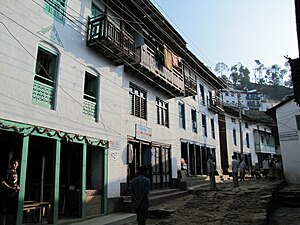Bhojpur Municipality
भोजपुर नगरपालिका | |
|---|---|
 Bhojpur Municipality | |
 Map of Bhojpur District showing all local level units | |
| Coordinates: 27°10′N 87°3′E / 27.167°N 87.050°E | |
| Country | |
| Province | Province No. 1 |
| District | Bhojpur District |
| Wards | 12 |
| Headquarter | Bhojpur |
| Government | |
| • Type | Mayor-council |
| • Mayor | Kailash Kumar Ale (NC) |
| • Deputy Mayor | Nirmala Sherpa (CPN (US)) |
| Area | |
| • Total | 159.51 km2 (61.59 sq mi) |
| Population (2011) | |
| • Total | 27,204 |
| • Density | 170/km2 (440/sq mi) |
| Time zone | NST |
| Postal code | 57000 |
| Area code | 029 |
| GDP (Nominal) | 2017 |
| - Total | RsBillion $Million(Billion, PPP) |
| - per capita | Rs $(PPP) |
| - GDP growth | Moderate (2016) |
| Licence plate prefixes | initiating with Province No 1, Koshi Zone |
| City flower | Rhododendron |
| City trees | Orange, Rudraksha and Amba |
| Climate | Cwb |
| Website | www |
Bhojpur (Nepali: भोजपुर) is one of the two urban municipalities of Bhojpur District of Province No. 1 of Nepal.
Bhojpur is the traditional home of the Kirat Rai people and has a long history since the settlement of the Kirat Rai people. Bhojpur bazaar is famous for its metalwork, particularly khukuri knives and Karuwa (metal vessels). It is home to many businesses as well as skilled craftsmen. Other major towns in the district include Dingla to the north, Ghoretar to the south, and Taksar near the airstrip, from where flights connect to Biratnagar and Kathmandu.[citation needed]
The design and construction of the 240 km Koshi Highway in east Nepal between Dharan on the Terai Plain and Num in the Middle Himalaya commenced in the early 1970s and was completed in 2012 when the first vehicles were able to drive to Num.[2] Construction of this highway links Bhjopur to other major cities and towns like Hile, Dhankuta and Dharan.
Historically it is a part of Majh Kirat (middle Kirat/ Khambuwan), and used to be called "east number 4". Middle Kirat consists mainly of Bhojpur and Khotang districts, the traditional home of kirat Rai people, an indigenous ethnic group of Nepal. In addition to Rais, other ethnic groups include castes like Chhetris, Bahuns, and Dalits.[citation needed]
- ^ "थप ४१ नगरपालिका घोषणा". कान्तिपुर दैनिक. Archived from the original on 2011-08-15. Retrieved 2011-08-23.
- ^ Hearn, G. J. (2017-07-27). "Engineering geomorphology of the Koshi Highway, east Nepal". Quarterly Journal of Engineering Geology and Hydrogeology. 50 (3): 354. doi:10.1144/qjegh2016-112. ISSN 1470-9236.

